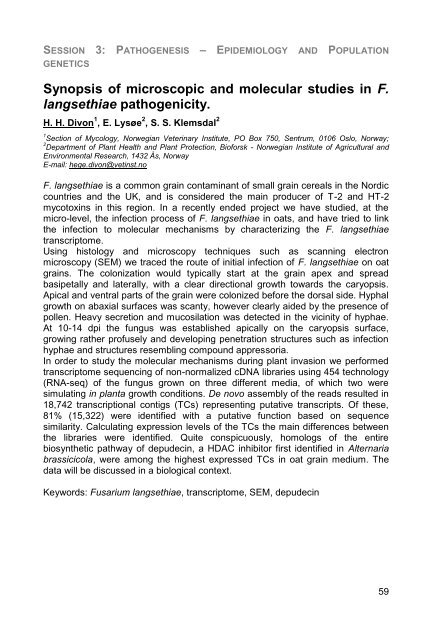EFS12- Book of abstracts - Contact
EFS12- Book of abstracts - Contact
EFS12- Book of abstracts - Contact
Create successful ePaper yourself
Turn your PDF publications into a flip-book with our unique Google optimized e-Paper software.
SESSION 3: PATHOGENESIS – EPIDEMIOLOGY AND POPULATION<br />
GENETICS<br />
Synopsis <strong>of</strong> microscopic and molecular studies in F.<br />
langsethiae pathogenicity.<br />
H. H. Divon 1 , E. Lysøe 2 , S. S. Klemsdal 2<br />
1 Section <strong>of</strong> Mycology, Norwegian Veterinary Institute, PO Box 750, Sentrum, 0106 Oslo, Norway;<br />
2 Department <strong>of</strong> Plant Health and Plant Protection, Bi<strong>of</strong>orsk - Norwegian Institute <strong>of</strong> Agricultural and<br />
Environmental Research, 1432 Ås, Norway<br />
E-mail: hege.divon@vetinst.no<br />
F. langsethiae is a common grain contaminant <strong>of</strong> small grain cereals in the Nordic<br />
countries and the UK, and is considered the main producer <strong>of</strong> T-2 and HT-2<br />
mycotoxins in this region. In a recently ended project we have studied, at the<br />
micro-level, the infection process <strong>of</strong> F. langsethiae in oats, and have tried to link<br />
the infection to molecular mechanisms by characterizing the F. langsethiae<br />
transcriptome.<br />
Using histology and microscopy techniques such as scanning electron<br />
microscopy (SEM) we traced the route <strong>of</strong> initial infection <strong>of</strong> F. langsethiae on oat<br />
grains. The colonization would typically start at the grain apex and spread<br />
basipetally and laterally, with a clear directional growth towards the caryopsis.<br />
Apical and ventral parts <strong>of</strong> the grain were colonized before the dorsal side. Hyphal<br />
growth on abaxial surfaces was scanty, however clearly aided by the presence <strong>of</strong><br />
pollen. Heavy secretion and mucosilation was detected in the vicinity <strong>of</strong> hyphae.<br />
At 10-14 dpi the fungus was established apically on the caryopsis surface,<br />
growing rather pr<strong>of</strong>usely and developing penetration structures such as infection<br />
hyphae and structures resembling compound appressoria.<br />
In order to study the molecular mechanisms during plant invasion we performed<br />
transcriptome sequencing <strong>of</strong> non-normalized cDNA libraries using 454 technology<br />
(RNA-seq) <strong>of</strong> the fungus grown on three different media, <strong>of</strong> which two were<br />
simulating in planta growth conditions. De novo assembly <strong>of</strong> the reads resulted in<br />
18,742 transcriptional contigs (TCs) representing putative transcripts. Of these,<br />
81% (15,322) were identified with a putative function based on sequence<br />
similarity. Calculating expression levels <strong>of</strong> the TCs the main differences between<br />
the libraries were identified. Quite conspicuously, homologs <strong>of</strong> the entire<br />
biosynthetic pathway <strong>of</strong> depudecin, a HDAC inhibitor first identified in Alternaria<br />
brassicicola, were among the highest expressed TCs in oat grain medium. The<br />
data will be discussed in a biological context.<br />
Keywords: Fusarium langsethiae, transcriptome, SEM, depudecin<br />
59
















![Présentation CRB-anim [Mode de compatibilité] - Inra](https://img.yumpu.com/17418636/1/190x135/presentation-crb-anim-mode-de-compatibilite-inra.jpg?quality=85)